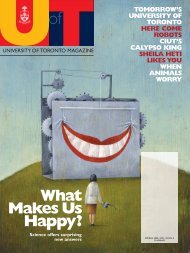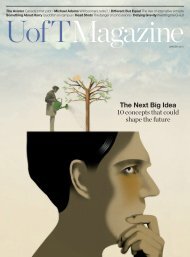Create successful ePaper yourself
Turn your PDF publications into a flip-book with our unique Google optimized e-Paper software.
Leading EdgeThomas and his colleagues noticedthe dying leaves in a 13.5-hectareresearch plot near Algonquin Provincial Park.Work began on this particular patch <strong>of</strong> forest –the first <strong>of</strong> such research “mega-plots” in NorthAmerica – in 2007 in an effort to understandtemperate forests through intensive study. It’s amethod that was pioneered 30 years ago in Panamaand Malaysia to study tropical forests, andto yield insight into a little-studied ecosystem.But Thomas says that we also have a lot tolearn about temperate and boreal forests.Although scientists have studied and managedthese forests for decades, their focus has <strong>of</strong>tenbeen on growing healthy trees quickly for logging.“Most <strong>of</strong> the history <strong>of</strong> traditional forestryresearch has been narrowly applied,” he says.Researchers at the Haliburton mega-plot aretrying to learn everything they can about thebasic biology <strong>of</strong> the forest. The first step was torecord, measure and map every woody-stemmedplant with a diameter <strong>of</strong> one centimetre or more− about 47,000 plants in all. This work was completedlast summer, and a team <strong>of</strong> graduatestudents are now analyzing the data. The censuswill allow them to track the growth and mortality<strong>of</strong> every tree in the forest over years.Scientists working on the plot use a network<strong>of</strong> 180 temperature sensors and a nearby meteorologicalinstrument tower. The 30-metre-hightower, run in collaboration with Jennifer Murphy,a pr<strong>of</strong>essor <strong>of</strong> chemistry, and Nate Basiliko,a pr<strong>of</strong>essor <strong>of</strong> geography, uses special equipmentto measure the exchange <strong>of</strong> carbondioxide, methane and other gases between theforest and the atmosphere.Thomas says the death <strong>of</strong> new leaves is aneffect few would have predicted for warmersprings; the researchers have ruled out othercauses, such as disease, pests and rainfall. Thefinding is a good example <strong>of</strong> the sort <strong>of</strong> unexpectedconsequences <strong>of</strong> global warming that theforest plot and instrumentation will helpresearchers understand. For instance, if warmertemperatures are going to kill leaves more <strong>of</strong>tenin the future, and if the death <strong>of</strong> those leavesslows forest growth or reduces the intake <strong>of</strong>carbon dioxide, then global warming might bequicker and more severe than currently predicted.– Kurt KleinerDo You Drink Too Much? A behaviouralscientist <strong>of</strong>fers new criteria for defininghow much is too muchAlthough serious alcoholics do plenty <strong>of</strong> damage to themselves and others,it’s the people with moderate drinking problems who cause the mosttrouble, simply because there are more <strong>of</strong> them − about four problemdrinkers for every one with a serious alcohol dependency.The bad news is that most <strong>of</strong> these problem drinkers – an estimated1.5 million in Ontario – never seek help. The good news is that relativelybrief and easy interventions can help them, says John A.Cunningham, a pr<strong>of</strong>essor <strong>of</strong> social and behavioural sciences.“In Canada, only one in three people who experience lifetime [alcohol]problems will ever seek treatment,” Cunningham says. They eitherdon’t think they have a problem, or would prefer to deal with it themselves.So Cunningham is developing quick and easy interventionmethods that are also effective.When problem drinkers take a 10-minute Internet survey thatCunningham developed, they cut their drinking by about a third. Thesurvey – at checkyourdrinking.net − asks about the amount <strong>of</strong> alcoholconsumed, and compares it to averages for others <strong>of</strong> the same age andsex. It also reports how much the drinker spends on alcohol, and his orher chances <strong>of</strong> suffering negative consequences from drinking.In 2007, Cunningham launched a study that included 72 problemdrinkers, about half <strong>of</strong> whom took his survey. He tracked their drinkingfor a year and found that, after six months, the survey participantshad reduced their alcohol consumption by 30 per cent more than thenon-participants, although after 12 months all drinkers had cut down.(Cunningham notes that many problem drinkers involved in a studyreduce alcohol consumption on their own. But he says his interventiongave the survey-takers a year with greater reductions.)Cunningham is now working on a similar questionnaire in the form<strong>of</strong> a pamphlet mailed to households. – Kurt KleinerPhoto: Image Source/Corbis18 WWW.MAGAZINE.UTORONTO.CA
















